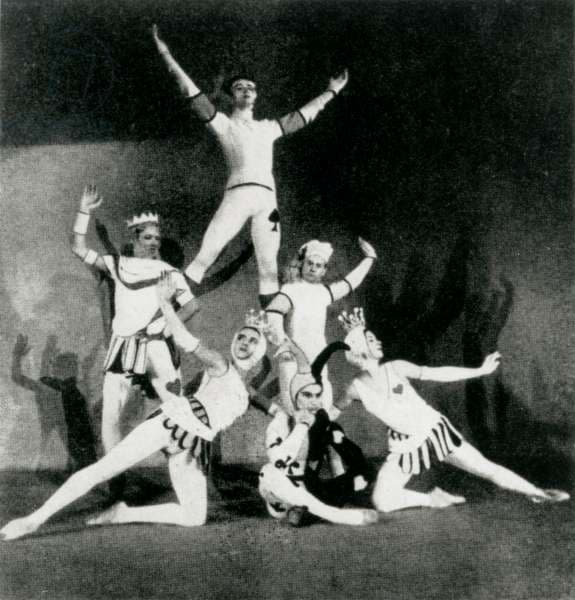Igor Stravinsky (1892–1971) was commissioned by Lincoln Kirstein’s American Ballet in 1935 for a work, completed in 1936 and it was staged in 1937. The work, Jeu de cartes (The Card Game), was choreographed by George Balanchine. The work, a ballet ‘in three deals’, had its premiere at the Metropolitan Opera House in April 1937 and was one of Stravinsky’s works in the Neo-Classical style. It was composed for the first Stravinsky Festival that George Balanchine put on in New York.

Stravinsky and Balanchine
One of Stravinsky’s fun works comes from his own interest in card games. The outer framework is based on the action that accompanies the beginning and end of every card game, i.e., the shuffling of the deck, here given in a marching motif. Between the beginning and ending shuffles, however, there’s a world of card gaming. The main character is not one of the face cards but, rather, the one card that shouldn’t be in play, the deceitful joker, who can transform itself into any card.

Jeu de cartes, 1937
The music is divided into three movements (the deals). The joker, in changing into any card, defeats all the other cards in the first two movements. In the last movement, however, he’s firmly defeated by a royal flush (the ace, king, queen, jack, and ten) in hearts.
The idea of a card-game ballet had been in Stravinsky’s head for more than a decade – the setting with ‘playing-card costumes and a green-baize gaming-table backdrop’ was visually exciting. The idea of the joker as the disturber might be imagined as the return of the murdered Petrushka from 1911, now free to wreak havoc.
Each movement opens with the same music (the shuffle). Within each movement, a wealth of other music is quoted. ‘There are scraps of music by Johann Strauss, Ravel, Beethoven, Debussy, and ultimately, in a piece of hysterical agon with the past, an asymmetrical but fully recognizable reading of Rossini’s overture to The Barber of Seville’. It’s almost like having a band playing just out of hearing at the village bandstand – it’s familiar but not really focused.
Igor Stravinsky: Jeu de cartes (The Card Game): Première donne (First Deal) (Berlin Philharmonic Orchestra; Igor Stravinsky, cond.)
As a ballet, the work had each ‘deal’ broken up into sections for various characters to have their turn in the spotlight:
First Deal (Première donne)
- Introduction.
- Pas d’action.
- Dance variation.
- Dance of the Joker.
- Waltz-Coda.
From its opening fanfare to a drunken-seeming waltz, to its ending with the sleepy winds, the first movement takes us through the first game safely.
Igor Stravinsky: Jeu de cartes (The Card Game): Deuxième donne (Second Deal) (Berlin Philharmonic Orchestra; Igor Stravinsky, cond.)
The second deal is more complicated, with an extended variation set in the middle.
Second Deal (Deuxième donne)
- Introduction.
- March.
- Variation I.
- Variation II
- Variation III
- Variation IV
- Variation V.
- Coda.
- Reprise of March.
- Ensemble.
Igor Stravinsky: Jeu de cartes (The Card Game): Troisième donne (Third Deal) (Berlin Philharmonic Orchestra; Igor Stravinsky, cond.)
The final deal, where the Joker gets its comeuppance, is where the Rossini quote makes its appearance.
Third Deal (Troisième donne).
- Introduction.
- Waltz.
- Battle between Spades and Hearts.
- Final Dance
- Coda.
In Balanchine’s original version, the dancers were dressed as the four suits in a deck of cards, with the joker as the central character. In 1992, Balanchine took up the work again and suggested that Peter Martins create new choreography to create a more abstract version of the ballet. Martins’ choreography was given its premiere in 1992 for the Diamond Project and in 2002, new sets and costumes were commissioned from Ian Falconer.

Jeu de cartes (Martins’ version), 2002 (New York City Ballet)
It is possible to give this simple card game a more nuanced reading. This is 1937 when the world is about to burst back into the ward. The evil joker disrupts the world of the kings and queens and it’s only through their united action (in the royal flush) that they are able to bring normality back. Balanchine himself described the plot as showing how the highest cards, which represent the most important people in society, can suffer defeat at the hands of smaller cards.
Neo-Classicism in Stravinsky finds its creative jolt coming from using old sources for new ideas. Historical models functioned as productive impulses for the composer and, in this way, made Neo-Classicism into an Avant-garde movement: Looking backward to move forward.
For more of the best in classical music, sign up to our E-Newsletter

